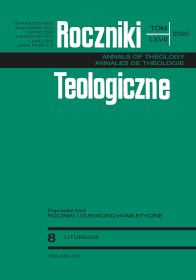The Acolyte’s Ministry Seen from a Spiritual and Liturgic Perspective
Abstract
The post-Tridentine rites for the ordination to the acolytate (minor orders) indicated that an acolyte was to be God's light for others (cf. Mt 5:16; Phil 2:15-16). Acolytes are also to be the children of light (cf. Eph 5:8; Lk 11:36), clothed with the armor of light (cf. Rom 13:12), and being zealous in all righteousness, goodness and truth they are to enlighten themselves, others and Church (cf. Eph 5:9). In addition, bringing wine and water to the altar they should sacrifice their own pure life and good works (cf. Rom 12:1). The acolyte’s spirituality according to motu proprio Ministeria quaedam and the rites of institution of acolytes consists mainly in the fulfilling of the common priesthood, both at the Eucharist table and in life. The acolyte's spirituality can also be called eucharistic which consists in making spiritual sacrifices in life and at the Holy Mass and joining them with the only sacrifice of Christ in each Eucharist. The eucharistic spirituality is also a spirituality of communion because it grows out of God as the communion of Persons and consists, on the human side, in building personal relationships with the Persons of the Holy Trinity. This leads to solidarity and service which means discovering people as sisters and brothers in one Church and creating bonds of friendship and cooperation with them in building the mystical Body of Christ. Therefore, the spirituality of communion consists in a real commitment to other people, real help for them and real actions aimed at building community between people, the source and summit of which is in the acolyte's serving brothers and sisters in the Eucharist.
References
Borek A., Święcenia duchowieństwa w późnośredniowiecznej Polsce: praktyka i jej uwarunkowania na przykładzie włocławskich wykazów święceń, „Studia Źródłoznawcze. Commentationes” 52(2014), s. 45-71.
Brzeziński D., Posługa stałego akolity i stałego lektora w Polsce w świetle Instrukcji Episkopatu Polski w sprawie udzielania posługi lektora i akolity świeckim mężczyznom (2007) oraz Dyrektorium Duszpasterstwa Służby Liturgicznej (2008), w: Memoriale Domini. Księga pamiątkowa dedykowana księdzu profesorowi Jerzemu Stefańskiemu w 70. rocznicę urodzin, red. M. Olczyk, W. Radecki, Gniezno: Gaudentinum 2010, s. 45-60.
Dyduch J., Udział świeckich w kulcie liturgicznym w świetle Kodeksu Prawa Kanonicznego, RBL 38(1985), nr 1, s. 16-28.
Dyduch J., Posługi liturgiczne świeckich w posoborowym prawodawstwie polskim, RBL 54(2011), nr 1, s. 21-32.
Górzyński J., Posługi świeckich w Kościele. Ministerium lektora i akolity, RT 48(2001), z. 8, s. 139-149.
Krakowiak Cz., Fermentum et sancta, EK V, kol. 136.
Krakowiak Cz., Posługi i funkcje świeckich w liturgii w świetle nowego „Ogólnego Wprowadzenia do Mszału rzymskiego” i instrukcji „Redemptionis Sacramentum”, w: Liturgia i ewangelizacja, red. W. Kazimieruk, I. Chłopkowska, Warszawa–Siedlce: Wyd. Sióstr Loretanek 2005, s. 21-48.
Krakowiak Cz., Lektor w historii i we współczesnych dokumentach Kościoła. Kobieta lektor, „Anamnesis” 46(2006), nr 3, s. 59-73.
Krakowiak Cz., Święcenia niższe, posługi i funkcje wiernych świeckich w liturgii, Lublin: TN KUL 2019.
Migut B., Duchowość eucharystyczna jako duchowość komunii, „Roczniki Liturgiczno-Homiletyczne” 59/4(2012), s. 77-86.
Nowowiejski A.J., Akolici i ich czynności podczas Mszy św. i w innych obrzędach Kościoła katolickiego, Warszawa: Drukarnia F. Czerwińskiego 1893.
Paweł VI, Litterae Apostolicae Motu proprio datae quibus disciplina «circa Primum Tonsuram, ordines minores et Subdiaconatum in Ecclesia Latina» innovatur, AAS 64 (1972), s. 529-534.
Pontificale Romanum. Pars prima, Editio typica, Typis Polyglottis Vaticanis 1962.
Pontificale Romanum. De institutione lectorum et acolythorum. De admissione inter candidatos ad diaconatum et presbyteratum. De sacro caelibatu amplectendo, Città del Vaticano: Typis Polyglottis Vaticanis 1972; tłum pol.: Pontyfikał rzymski. Obrzędy ustanowienia lektorów i akolitów oraz przyjęcia kandydatów do diakonatu i prezbiteratu, Katowice: Księgarnia św. Jacka 2014.
Righetti M., Manuale di storia liturgica, t. 4. I sacramenti – i sacramentali, Milano: Ancora 1959.
Rutkowski A., Formacja zespołów służby liturgicznej w życiu Kościoła partykularnego, „Warszawskie Studia Teologiczne” 25(2012), z. 1, s. 213-223.
Rzeźwicki G., Duszpasterstwo ministrantów i lektorów w kościele w Polsce podczas Soboru Watykańskiego II i w okresie posoborowym (1964-2008), Tarnów: Biblos 2010.
Rzeźwicki G., Od kandydata przez stopnie ministranta, funkcję lektora i ceremoniarza do animatora (wokół problemów formacji służby liturgicznej), Tarnów: Biblos 2018.
Szczepaniec S., Ceremoniał posług liturgicznych, Kraków: Wydawnictwo Kurii Metropolitalnej 1987.
Szczepaniec S., Posługiwanie świeckich w liturgii. Zasady ogólne, RT 48(2008), z. 8, s. 113-137.
Schenk W., Akolita, EK I, kol. 239.
Copyright (c) 2020 Roczniki Teologiczne

This work is licensed under a Creative Commons Attribution-NonCommercial-NoDerivatives 4.0 International License.





